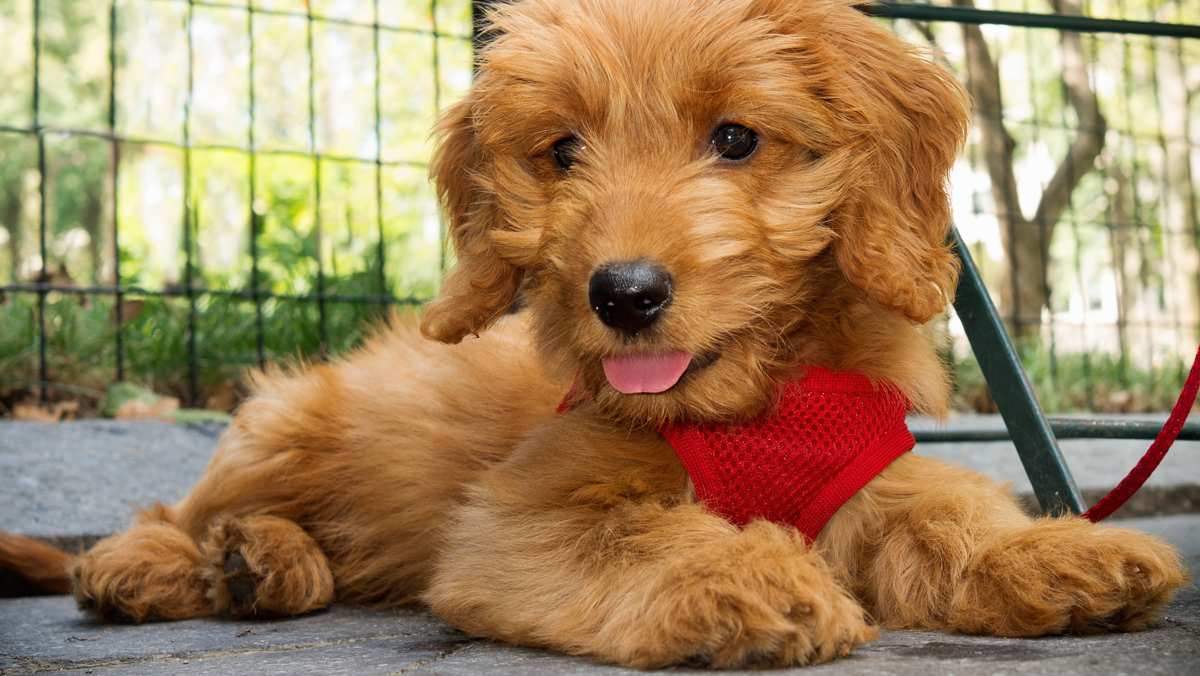Petite Goldendoodle Breed Details
Below are details and specs for the Petite Goldendoodle breed.

The Petite Goldendoodle is a hybrid crossbreed consisting of a mix of 50 percent Miniature Poodle, 25 percent Golden Retriever, and 25 percent Cocker Spaniel (though some variations of this combination exist). They are small- to medium-sized, and have moderate fur length. Known as one of the "sweetest" of all dog breeds, these dogs are very social animals, and are affectionate to people and other animals. Members of this breed make suitable indoor companions and rarely shed. The breed is low-maintenance, and has few health concerns.
Below are details and specs for the Petite Goldendoodle breed.
Petite Goldendoodles, because they are a hybrid crossbreed, vary in size. Weight ranges from 15-40 pounds; height, 10-18 inches at the shoulder.
Moderately intelligent, extremely affectionate, and somewhat mischievous, this breed is highly social. It is very good with children, other pets, and strangers, but can be rambunctious and temperamental, especially if left alone.
These dogs are extremely low-maintenance. They shed very little, require little brushing, and are clean; the breed has an excellent health record. They are easily exercised with daily walks and outdoor playtime.
As a hybrid crossbreed, little information exists about the exact origin of the Petite Goldendoodle, but one of the first recorded cases was in the late 1990s at Timshell Farms in Texas. There, the farm owners worked with a breeding specialist to produce a Golden Retriever-Cocker Spaniel mix (which the farm owners called "Petite Golden Retrievers"); these dogs were small enough as females to naturally mate with a Miniature Poodle sire, which produced what is now known as the Petite Goldendoodle. Since that time, breeders have used a variety of methods to breed these dogs; breeders have been known to use Miniature or Toy Poodles (and in some cases even small Standard Poodles) to produce the Petite Goldendoodle. But the effort at Timshell Farms, which itself took several years to achieve, is the most well-known case.
With such a wide variety of genetic influence, these dogs can vary in appearance. A Petite Goldendoodle is small- to medium-sized, and can display physical attributes of the Golden Retriever, Poodle, or Cocker Spaniel – and often a combination of two of these, or all three. The breed often has medium-length, shaggy fur, a moderate-sized, “blunted” head, and large, floppy ears. Its body is usually a bit longer than its height, and depending on genetics, its legs can be medium-length to long. These dogs have thick skin, and medium to long tails.
Petite Goldendoodles, as hybrids, will vary in terms of appearance and temperament. It is best to consult with your breeder of choice if you are unsure which generation is right for you. The F1 generation is the first cross between a purebred Golden Retriever and purebred Poodle, resulting in a litter of PGDs; one of these may be crossed back (F1B) to a Golden Retriever or Poodle to enhance certain desired characteristics, i.e. make the coat curlier. F2s are obtained when 2 F1 Petite Goldendoodles are bred together; once again, crossing one of these F2s with a Poodle or Golden Retriever will result in an F2B. F3 PGDs are the result of crossing two F2s..
This breed has fair intelligence, but it is known for its “sweetness” and is very affectionate to people and other animals. Petite Goldendoodles are very social dogs and are extremely easy to train, but some are considered temperamental and moody. Some Petite Goldendoodles are known for their mischievousness as well. They possess a medium amount of energy, and can be fairly playful. The breed is considered non-aggressive, and has a low tendency to bark.
Petite Goldendoodles are low-maintenance. They shed very little, especially if their fur is trimmed regularly; they are very clean, so they require baths only 3-4 times per year. They require daily exercise that can be met via walks or outdoor playtime. Members of this breed have few known health issues, likely due to the genetic variation that comes with being a hybrid.
This breed sheds very little, so brushing once per week is plenty. In addition, the typical regimen of bimonthly nail trimming, ear cleaning is recommended along with weekly teeth brushing.
Only moderate amounts of exercise are needed for these dogs so a daily walk or outdoor playtime will suffice. Breeders recommend weekly trips to the park, where a Petite Goldendoodle, because of its inquisitive and mischievous nature, can explore unknown territory.
These dogs require little space, so practically any living situation is suitable for them.
Life expectancy is 10-15 years. No major health concerns exist for this breed; a few Petite Goldendoodles are known to suffer from hip dysplasia, which is a malformation of the hip joint.
Below are potential health concerns associated with Petite Goldendoodles.